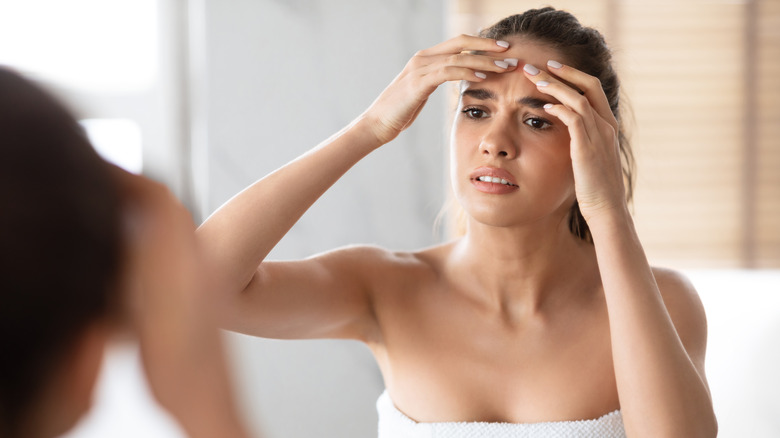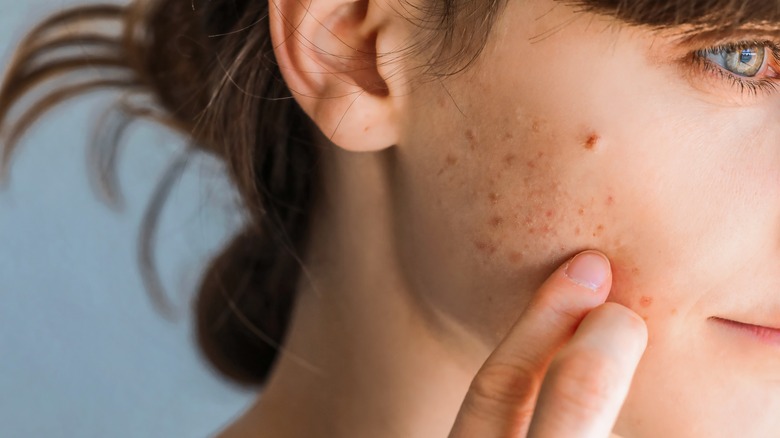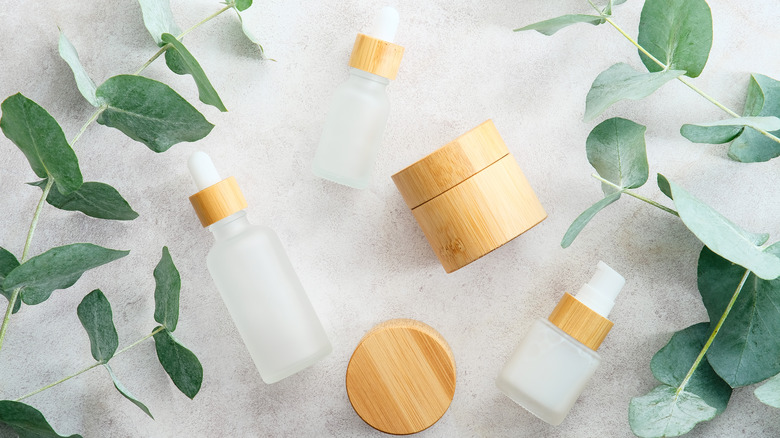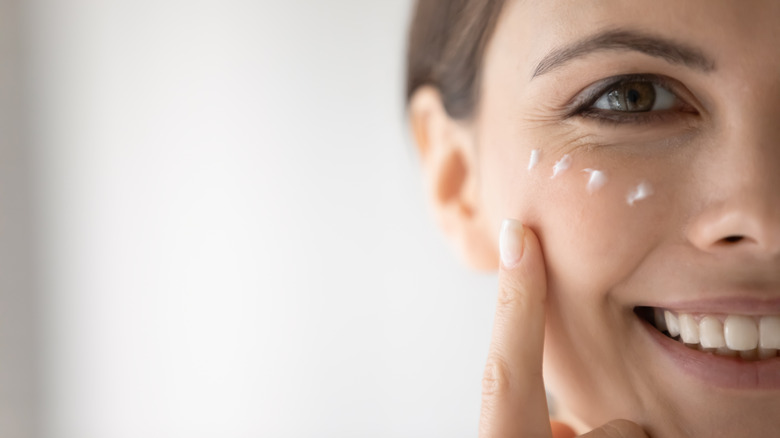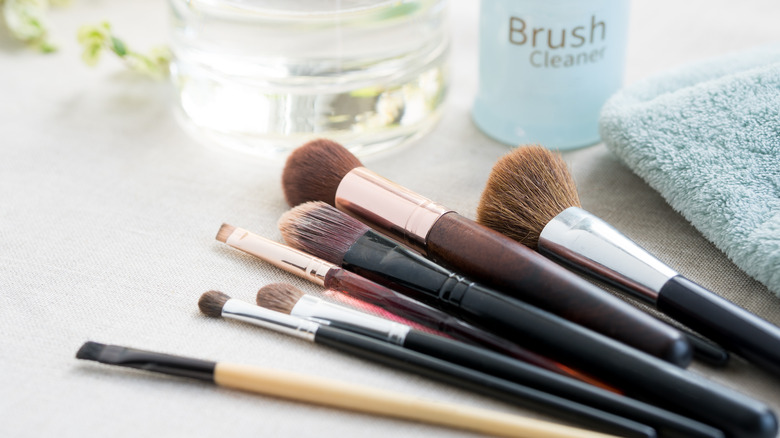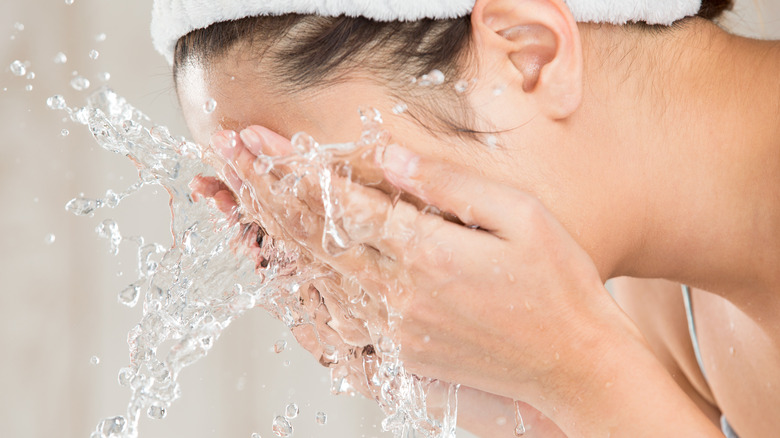Your Guide To Identifying And Preventing Cosmetic Acne
Acne is a skin condition that occurs when pores become blocked. They can appear on most parts of the body in many different forms. Blackheads are very common; they're tiny open comedones filled with excess oil and dead skin cells. When closed, they're called whiteheads. Papules are what people associate with a pimple, but when it becomes filled with pus and ready to pop, it's called a pustule. Acne becomes more severe when people have nodules and cysts. These are the pimples that sit deep under the skin and are painful. Nodules are when the pimples are solid, and cysts are when they're filled with pus.
Sebum and bacteria are known for causing pimples, but dead skin cells and hair can also. However, the Cleveland Clinic explains that hormones play a significant role. Specifically, androgen hormones — like testosterone — cause breakouts for teenagers and young adults. Older people can suffer from acne for other reasons. Genetics, fluctuating hormones, stress, and diet can also cause pimples. Yet, there is another factor, a different type of acne that can be caused by your environment, including what haircare, skincare, and makeup you use.
How to identify cosmetic acne
Identifying cosmetic acne can be tricky. Already suffering from other types of acne can make it even harder to do. It's difficult because the time from using a product to seeing the cosmetic acne ranges from a couple of days to 6 months later. Since this is such a long time, you may not know what product is causing the breakout. Signs that your complexion is suffering from cosmetic acne are what type of pimples you have and where they are. The American Academy of Dermatology Association describes the breakouts as tiny whiteheads and large spots. They can grow anywhere but are most likely seen on the forehead, cheeks, and chin.
Lots of makeup and skincare can cause cosmetic acne, including foundation, blush, concealer, moisturizer, and toner. Even some haircare products you apply around the frame of your face can lead to acne. Suffering from cosmetic acne is tricky because as new pimples grow, you're tempted to cover them up with the makeup that may be the root of the problem, starting the cycle again. Using products with benzoyl peroxide, salicylic acid, and adapalene can help treat any existing cosmetic acne. Although, you need to be patient because it will take at least 4 to 8 weeks to clear up.
Stick to non-comedogenic products
The types of products you use affect your chances of developing cosmetic acne. They can clog your pores and leave your face covered in pimples. Plus, if you already suffer from acne, these products will worsen it. An excellent way to know if a product is safe to use is if the label says it's non-comedogenic. This means that the ingredients won't clog your pores. However, Medical News Today explains that the FDA does not relegate this term, so manufacturers don't have to do testing before writing non-comedogenic on the label.
While these products won't cure any cosmetic acne you already have, they will prevent new pimples from appearing. Makeup and skincare products that are non-comedogenic will include ingredients like aloe vera, glycerin, and Vitamin C. Mineral-based makeup also has less chance of causing pimples. Ingredients to stay away from are coconut oil, cocoa butter, and lanolin.
Prep your skin
How you prep your skin for makeup is just as important as what you use. This is the first layer of products that sit on your face and sink into your pores. In this step, your hands act like your makeup brushes, so make sure they're clean. First, you want to wash your face. Dermatologist Joshua Zeichner, MD, explained to Makeup.com that cleansing your complexion removes dirt, dead skin cells, and oil. He recommends using a cleanser with salicylic acid for the best results because it will help clarify the skin.
After washing your face, you need to moisturize it. Lily Njoroge, a New York-based esthetician, told Rose Inc that moisturizers with anti-inflammatory ingredients would perform the best. Having a layer of lotion on your face will make your makeup easier to apply and cause it to sit better on the skin. She also recommends following up with a lightweight sunscreen. An SPF of at least 30 protects the skin from more than sunburns. It also stops any cosmetic acne you may already have from scaring.
Clean your makeup brushes
Dirty makeup brushes are one of the biggest culprits for cosmetic acne. Not only are they covered in residue from your foundation, blush, bronzer, and eyeshadow, but they also are filled with dirt and oil. The American Academy of Dermatology Association explains that these brushes are a breeding ground for bacteria, which can cause acne and infections like E.coli. To protect your health, wash your makeup brushes every 7 to 10 days.
Luckily, washing these brushes is a relatively easy activity. First, rinse them under water, ensuring that the base of the brush head doesn't get wet. Otherwise, the glue that holds the bristles in place could dissolve and ruin your brushes. Then fill a bowl with warm water and a tablespoon of soap. Shampoo, clarifying shampoo, or a gentle soap will work. Spin the brush in the bowl and then massage it in the palm of your hand. Next, rinse it under running water. Continue these steps until the water runs clear. Lastly, squeeze out any excess liquid and leave your brushes to dry on a towel with the bristles hanging off the counter's edge.
Always remove your makeup before bed
Makeup sits on your face all day, collecting dirt from the places you've been. If you go to sleep with it still on, not only are you exposing yourself to this grime for longer, but it can inhibit the effectiveness of any nighttime products you use. Regularly washing your face is the best way to keep your complexion feeling and looking healthy. Dermatologist Julie Russak, MD, explained to Aedit that leaving makeup on the skin all day and night allows it to be reabsorbed into your pores and causes acne. It also stops the natural excretion of toxins and the regeneration of skin that occurs while you're sleeping.
You must follow at least two steps to wash makeup off your face correctly. First, you need to remove the makeup. You can do this with an oil-based cleanser or micellar water. Once your makeup is gone, you need to use a cleanser. This removes dead skin cells, toxins, and environmental build-up. For this step, you should use a gel, cream, or foaming cleanser. Then you can follow up with your favorite skincare products.
